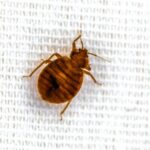
It’s hard to believe summer has come and gone and back-to-school season on Long Island is almost here! While it’s always an exciting time, after the past year of limited social interactions and remote learning for many, heading back to class is sweeter than ever, and we want to help you keep it that way…without back-to-school pests! Here are a few critters to be on the lookout for.
Back to School Pest #1: Bed Bugs
Bed bugs are hitchhiking pests who thrive during the post-summer travel, back-to-school season. These nocturnal pests are small, rusty red or mahogany in color, resemble apple seeds, and feed on human blood by biting, often while their hosts are fast asleep.
In order to survive and develop, bed bugs must have these blood meals. If they haven’t fed recently, their bodies will be clear and flat, but after they’ve taken a blood meal, their color changes to a purple-red color and they become larger in size.
How Do You Get Bed Bugs?
Bed bugs are found virtually everywhere humans gather, and are especially common in Long Island homes, on public transportation and school buses, classrooms, college dorms, apartment complexes, and in libraries, hospitals, theaters, and offices. Bed bugs travel long distances (especially for their small size!) by latching onto backpacks and luggage, clothes, and linens.
No matter how clean your home is, you can end up with bed bugs.
Signs of Bed Bugs
- Bloodstains on bedding or the walls around beds
- Visible bugs!
- Small, pearly white eggs in clusters
- Remains of exoskeletons, feces, or bed bug egg casings
- Bites, often in clusters, which look like red welts on the skin and burn and itch
- A musty, unpleasant odor that reminds you of wet shoes or clothes
Back to School Pest #2: Ticks
Although summer is prime tick season, ticks remain active on Long Island throughout the fall, too, and are a common back to school pest. Particularly for parents of younger children who are allowed recess time each day, it’s important to perform daily tick checks on your kids.
How Do You Get Ticks?
Ticks are common in grass and shrubs, such as those of school playgrounds and ball fields, where they’ll seek out hosts by sensing a host’s breath, body odor, body heat, moisture, or vibrations. While ticks can’t fly or jump, they will wait in a position known as “questing.” While questing, ticks hold onto leaves and grass by their third and fourth pair of legs. They hold the first pair of legs outstretched, waiting to climb onto the host. When a host brushes the spot where a tick is waiting, it quickly climbs aboard.
Risks of Ticks on Long Island
As discussed in last week’s blog post, on Long Island, we see three primary tick species: the American Dog Tick/Wood Tick, the Lonestar Tick, and the Deer Tick. While each of these tick species has its own unique behaviors and physical characteristics, they all share a major trait—they can transmit several life-threatening diseases, including: Lyme Disease, Tularemia, Rocky Mountain Spotted Fever, Babesiosis, Bourbon Virus, Southern Tick-Associated Rash Illness (STARI), and more. Because of this, it’s vital to protect your children with long sleeves and pants when possible and daily checks for ticks if your kids spend time outside.
Back to School Pest #3: Ants
Even though they probably won’t hitchhike home from school on your kids or their backpacks, ants can be a sneaky back to school pest given the opportunity.
Where Do Ants Come From?
Back to school means lunchboxes full of all the tasty treats ants know and love. Ants are opportunistic eaters, but they particularly enjoy sugary bites and drinks and greasy foods.
How to Prevent Ants
If your kids don’t finish everything in their lunchbox during the school day, encourage them to either throw away their scraps all together or enclose any leftovers securely in a bag or container. If any drinks spill, especially inside or around their lunchboxes or backpacks, wash them off thoroughly to prevent sticky residue buildup that will attract ants to your home.
Take the Stress Out of Back to School Season with Suburban Exterminating
The back to school season is stressful enough without adding pest invasions into the mix. For help preventing pests all year long, we recommend one of our Annual Protection Plans. Call or text (631/516) 864-6900 for help choosing your family’s today!





